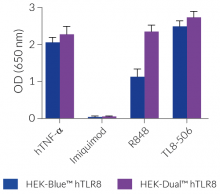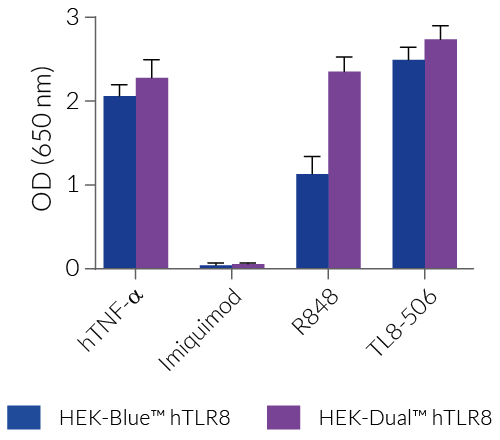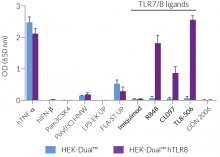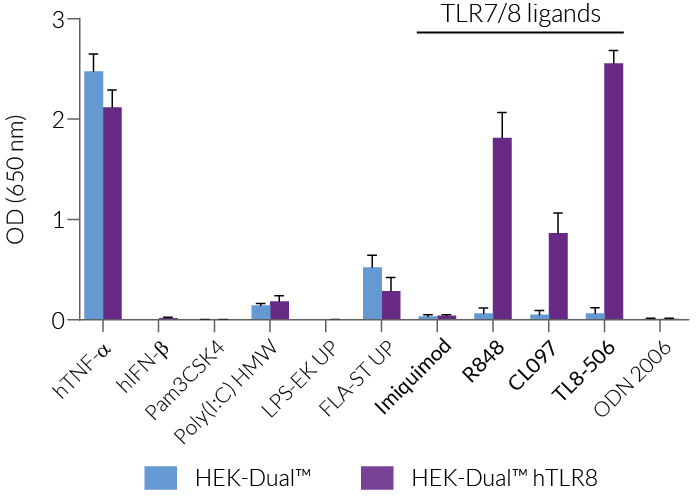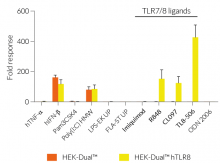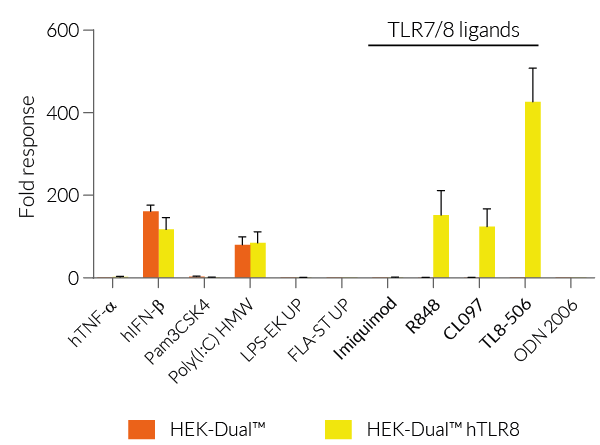Human TLR8 Reporter HEK293 Cells (NF-κB and IRF)
| Product | Unit size | Cat. code | Docs. | Qty. | Price | |
|---|---|---|---|---|---|---|
|
HEK-Dual™ hTLR8 Cells Human TLR8 expressing HEK293 dual reporter cells (NF-κB and IRF pathways) |
Show product |
3-7 x 10e6 cells |
hkd-htlr8
|
|
NF-κB–SEAP and IRF–Lucia reporter HEK293 cells expressing human TLR8

Signaling pathways in HEK-Dual™ hTLR8 cells
(click to enlarge and see legend)
HEK-Dual™ hTLR8 cells were engineered from the human embryonic kidney HEK293 cell line to study the human Toll-like receptor 8 (hTLR8). This important pattern recognition receptor (PRR) recognizes - together with TLR7 - single-stranded (ss)RNA structures, a hallmark of viral replication, and triggers antiviral immune responses [1].
Description
HEK-Dual™ hTLR8 cells feature the stable expression of the TLR8 gene as well as two inducible reporter genes for SEAP (secreted embryonic alkaline phosphatase) and Lucia luciferase. As a result, these cells allow the simultaneous study of the NF-κB pathway, by monitoring the activity of SEAP, and the IRF pathway, by assessing the activity of the secreted Lucia luciferase. Upon TLR8 activation, both reporter proteins are readily measurable in the cell culture supernatant when using QUANTI-Blue™ Solution, a SEAP detection reagent, and QUANTI-Luc™ 4 Lucia/Gaussia, a Lucia luciferase detection reagent.
HEK-Dual™ hTLR8 cells show potent NF-κB and IRF responses upon incubation with TLR8-specific ligands, such as TL8-506 when compared to HEK-Blue™ hTLR8 cells and their parental cell line HEK-Dual™ (see figures). They do not respond to TLR7-specific ligands, since HEK293 cells do not express endogenous TLR7. However, as they express endogenous levels of various PRRs, such as TLR3 and TLR5 [in-house data], HEK-Blue™ hTLR8 cells may respond to their cognate ligands Poly(I:C) and flagellin (see figures).
Key features:
- Stable expression of human TLR8
- Strong response to TLR7/8- and TLR8-specific ligands
- Distinct monitoring of TLR8-dependent NF-κB or IRF activation by assessing the SEAP and Lucia luciferase activities
Applications:
- Defining the role of TLR8-dependent IRF and NF-κB signaling pathways
- Screening for novel TLR8 agonists and inhibitors
References
1. Heil F. et al., 2004. Species-specific recognition of single-stranded RNA via Toll-like receptor 7 and 8. Science. 303:1526.
Back to the topSpecifications
Antibiotic resistance: Blasticidin, Puromycin, Zeocin®
Growth medium: DMEM, 4.5 g/l glucose, 2 mM L-glutamine, 10% (v/v) fetal bovine serum, 100 U/ml penicillin, 100 μg/ml streptomycin, 100 μg/ml Normocin™
Quality Control:
- Human TLR8 expression has been verified by RT-qPCR and functional assays.
- The stability for 20 passages, following thawing, has been verified.
- These cells are guaranteed mycoplasma-free.
All of these products are covered by a Limited Use License (See Terms and Conditions).
Back to the topContents
- 1 vial containing 3-7 x 106 cells
- 1 ml Blasticidin (10 mg/ml)
- 1 ml Puromycin (10 mg/ml)
- 1 ml Zeocin® (100 mg/ml)
- 1 ml Normocin™ (50 mg/ml)
- 1 ml of QB reagent and 1 ml of QB buffer (sufficient to prepare 100 ml of QUANTI-Blue™ Solution, a SEAP detection reagent)
- 1 tube of QUANTI-Luc™ 4 Reagent, a Lucia luciferase detection reagent (sufficient to prepare 25 ml)
![]() Shipped on dry ice (Europe, USA, Canada and some areas in Asia)
Shipped on dry ice (Europe, USA, Canada and some areas in Asia)
FAQ Cell Lines
 Any questions about our cell lines ? Visit our frequently asked questions page
Any questions about our cell lines ? Visit our frequently asked questions page
Back to the top
Details
Toll-Like Receptor 8
In humans, four Toll-Like Receptor (TLR) family members TLR3, TLR7, TLR8, and TLR9, mainly found in the endosome, are specialized in sensing viral-derived components. TLR7 and TLR8 recognize single-stranded (ss)RNA structures, such as viral ssRNA, miRNA, and various synthetic agonists [1]. Despite their similarities in PAMP (pathogen-associated molecular pattern) recognition, structure, and signaling partners, they highly differ in expression profiles and signaling responses, with TLR7 being more involved in the antiviral immune response and TLR8 mastering the production of proinflammatory cytokines [2]. TLR7 is mainly found in plasmacytoid dendritic cells (pDCs) and B cells, whereas TLR8 is highly expressed in monocytes, monocyte-derived DCs (mDCs), and macrophages [3].
TLR8 signaling
Upon viral infection, TLR8 translocates from the endoplasmic reticulum via the Golgi into the endosomes. Subsequently, it undergoes proteolytic cleavage in order to facilitate dimer rearrangement [1,3]. While TLR7 dimerizes upon ligand binding, TLR8, which exists as an unliganded inactive dimer, performs structural reorganization after ligand recognition [4]. Once activated, TLR8 recruits the adaptor protein MyD88 to trigger IRF, AP-1, and NF-kB responses via TRAF6 (TNF receptor-associated factor 6) [1,3]. Depending on the stimulus and cell type, TLR8-mediated signaling induces Th1-type cytokine (IL-12) production [5].
TLR8 therapeutic targeting
The involvement of nucleic acid-sensing mechanisms in the immune response against infections and other diseases makes them interesting targets for drug design [5]. TLR7/8 agonists are currently been tested as vaccine adjuvants and immunomodulatory therapeutics. They are extensively studied in the context of viral infection (e.g. SARS-CoV-2, Influenza, HIV), autoimmune (e.g. asthma, Lupus), and autoinflammatory diseases (e.g. cancer) [1-5]. Understanding the fundamental differences between these two related receptors could potentially be harnessed to discover novel drugs and improve vaccine efficacy/safety [5].
References:
1. Martínez-Espinoza I & Guerrero-Plata A. 2022. The Relevance of TLR8 in Viral Infections. Pathogens. 11(2):134.
2. Salvi V, et al., 2021. SARS-CoV-2-associated ssRNAs activate inflammation and immunity via TLR7/8. JCI Insight.;6(18):e150542.
3. Georg P. & Sander L.E., 2019. Innate sensors that regulate vaccine responses. Curr. Op. Immunol. 59:31.
4. Asami J, Shimizu T. 2021. Structural and functional understanding of the toll-like receptors. Protein Sci. (4):761-772.
5. de Marcken M, et al., 2019. TLR7 and TLR8 activate distinct pathways in monocytes during RNA virus infection. Sci Signal.;12(605):eaaw1347.





